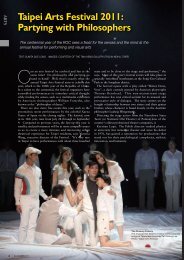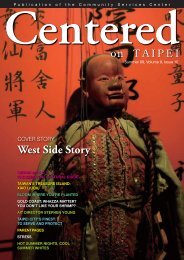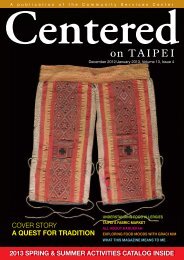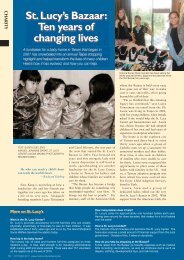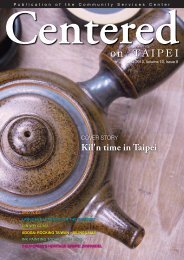Rice 米 [mi] - Community Services Center
Rice 米 [mi] - Community Services Center
Rice 米 [mi] - Community Services Center
Create successful ePaper yourself
Turn your PDF publications into a flip-book with our unique Google optimized e-Paper software.
ice <strong>米</strong> [<strong>mi</strong>]<br />
TExT: IVY CHEn<br />
IMAGES: IVY CHEn, xIAnG TInG And ISABEllA<br />
<strong>Rice</strong> far<strong>mi</strong>ng has a long history in the Far East: fields dating back nine and three<br />
thousand years have been found in China and Taiwan respectively. In Taiwan, rice<br />
is harvested twice each year. The first crop is planted in January and cut in July,<br />
while the second grows from July to December. There are basically three types<br />
of rice to be found in Taiwan markets. Taiwan Japonica rice, the most common,<br />
was introduced from Japan, and has produced many sub-types in Taiwan. Indica<br />
rice, which is normally used in cakes and noodles, was transplanted from China,<br />
and has also been improved via many sub-types in Taiwan. The third type,<br />
glutinous rice, is used in both savory dishes and desserts as well as in making<br />
wine and vinegar, and various kinds of dumplings and cakes.<br />
typeS of rice<br />
Most of the above types of rice are<br />
also available organically grown.<br />
Taiwan Japonica rice ( 台 灣 梗 <strong>米</strong><br />
taiwan geng<strong>mi</strong> or 台 梗 taigeng):<br />
Short grain: has a chewy texture after<br />
cooking.<br />
Brown rice ( 糙 <strong>米</strong> cao<strong>mi</strong>): rice is<br />
husked and retains all the nutrition.<br />
White rice ( 白 <strong>米</strong> bai<strong>mi</strong>): rice is<br />
husked and <strong>mi</strong>lled, and no longer<br />
contains bran or germ.<br />
Embryo rice ( 胚 芽 <strong>米</strong> peiya<strong>mi</strong>): rice is<br />
husked and <strong>mi</strong>lled, but still has germ<br />
attached.<br />
medium grain.<br />
White rice ( 在 來 白 <strong>米</strong> zailai bai<strong>mi</strong>):<br />
medium grain and ground into<br />
powder.<br />
Glutinous rice ( 糯 <strong>米</strong> nuo<strong>mi</strong>):<br />
White, red or black in color;<br />
medium long & short grain; sticky<br />
texture after cooking.<br />
White rice ( 白 糯 <strong>米</strong> bai nuo<strong>mi</strong>):<br />
medium long, short grain and<br />
ground into powder.<br />
Red rice ( 紅 糯 <strong>米</strong> hong nuo<strong>mi</strong>):<br />
medium long grain.<br />
Black rice ( 黑 糯 <strong>米</strong> hei nuo<strong>mi</strong>):<br />
medium long grain.<br />
BuyinG rice<br />
<strong>Rice</strong> with a higher ratio of whole<br />
grain is healthier. Any damaged,<br />
broken or yellow rice should be<br />
discarded. Look for the CAS (Certified<br />
Agricultural Standards) logo on the<br />
packaging, which guarantees quality.<br />
Indica rice ( 秈 <strong>米</strong> xian<strong>mi</strong> or 在 來 <strong>米</strong><br />
zailai<strong>mi</strong>):<br />
Medium long grain: fluffy texture<br />
after cooking.<br />
Brown rice ( 在 來 糙 <strong>米</strong> zailai cao<strong>mi</strong>) :<br />
30 september 2011 www.communitycenter.org.tw
White rice grains should be translucent<br />
to transparent.<br />
uSe of different typeS of rice<br />
Taiwan Japonica rice: steamed, in<br />
porridge and sushi.<br />
Indica rice: Steamed, and in various<br />
types of rice noodle and rice cake.<br />
Glutinous rice: White short grain rice<br />
is used for desserts and making wine<br />
and vinegar; white medium long grain<br />
rice is made into dumplings and cakes.<br />
Red and black grains are for stea<strong>mi</strong>ng<br />
and desserts.<br />
nutrition<br />
<strong>Rice</strong> contains carbohydrates, protein,<br />
fat, dietary fiber, vita<strong>mi</strong>n B-complex,<br />
and <strong>mi</strong>nerals, especially phosphorus.<br />
It can reduce blood pressure, improve<br />
diabetes and cardiovascular disease and<br />
reduce the incidence of cancer, and can<br />
prevent constipation, help in weight<br />
control and other<br />
health functions.<br />
cookinG tipS<br />
1. Rinse rice 2~3 times<br />
gently and quickly.<br />
Change water for<br />
every wash.<br />
2. R i c e s h o u l d b e<br />
soaked in water<br />
from 30 <strong>mi</strong>nutes<br />
(white rice) to four<br />
hours (brown rice)<br />
or as instructed on<br />
the package before cooking.<br />
3. If cooking rice in a rice cooker, use<br />
one cup of water for each cup of<br />
rice or 1.6 cups of water for each<br />
cup of brown rice, or follow the<br />
instructions on the package.<br />
4. Always allow the cooked rice to sit<br />
in the rice cooker with the lid on<br />
for about twenty <strong>mi</strong>nutes after the<br />
cooker switches off.<br />
5. If cooking rice in a<br />
pot on the stove, add<br />
about two cups of<br />
water to each cup of<br />
rice, bring to a boil and<br />
cook until the water<br />
is level with the top of<br />
the rice. Turn heat off<br />
and cover with a lid.<br />
Allow to sit for twenty<br />
<strong>mi</strong>nutes.<br />
6. Fluff the cooked rice<br />
with a rice spatula to<br />
allow excess steam to escape before<br />
serving.<br />
StoraGe<br />
Place rice in refrigerator after<br />
opening.<br />
For more information in English,<br />
please see the link: http://www.cas.<br />
org.tw/en/<br />
CsC busINess CLassIFIeD<br />
education<br />
Beauty<br />
Sport<br />
hair dreSSer<br />
www.communitycenter.org.tw september 2011<br />
31


![Rice 米 [mi] - Community Services Center](https://img.yumpu.com/22967832/1/500x640/rice-mi-community-services-center.jpg)
